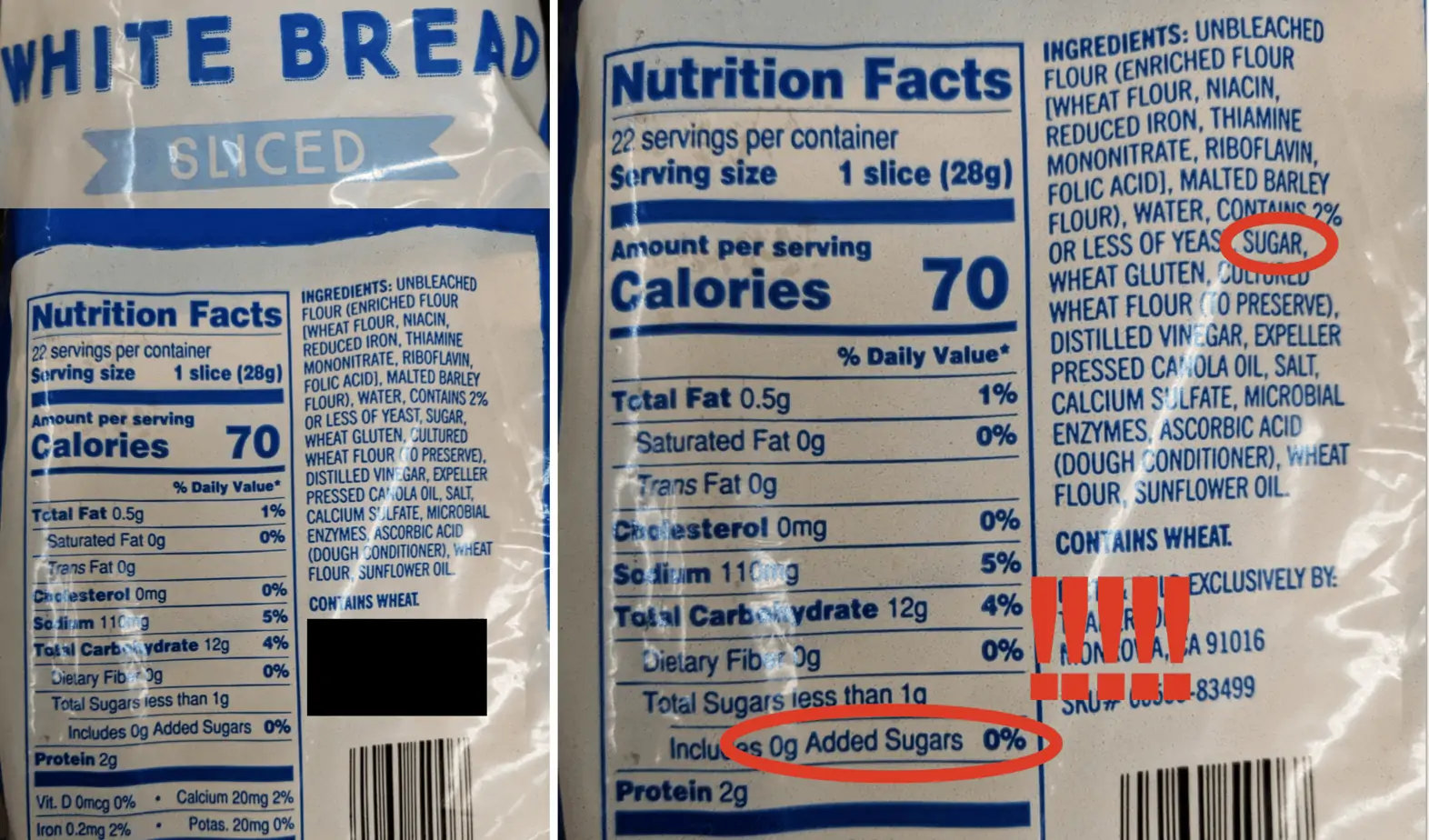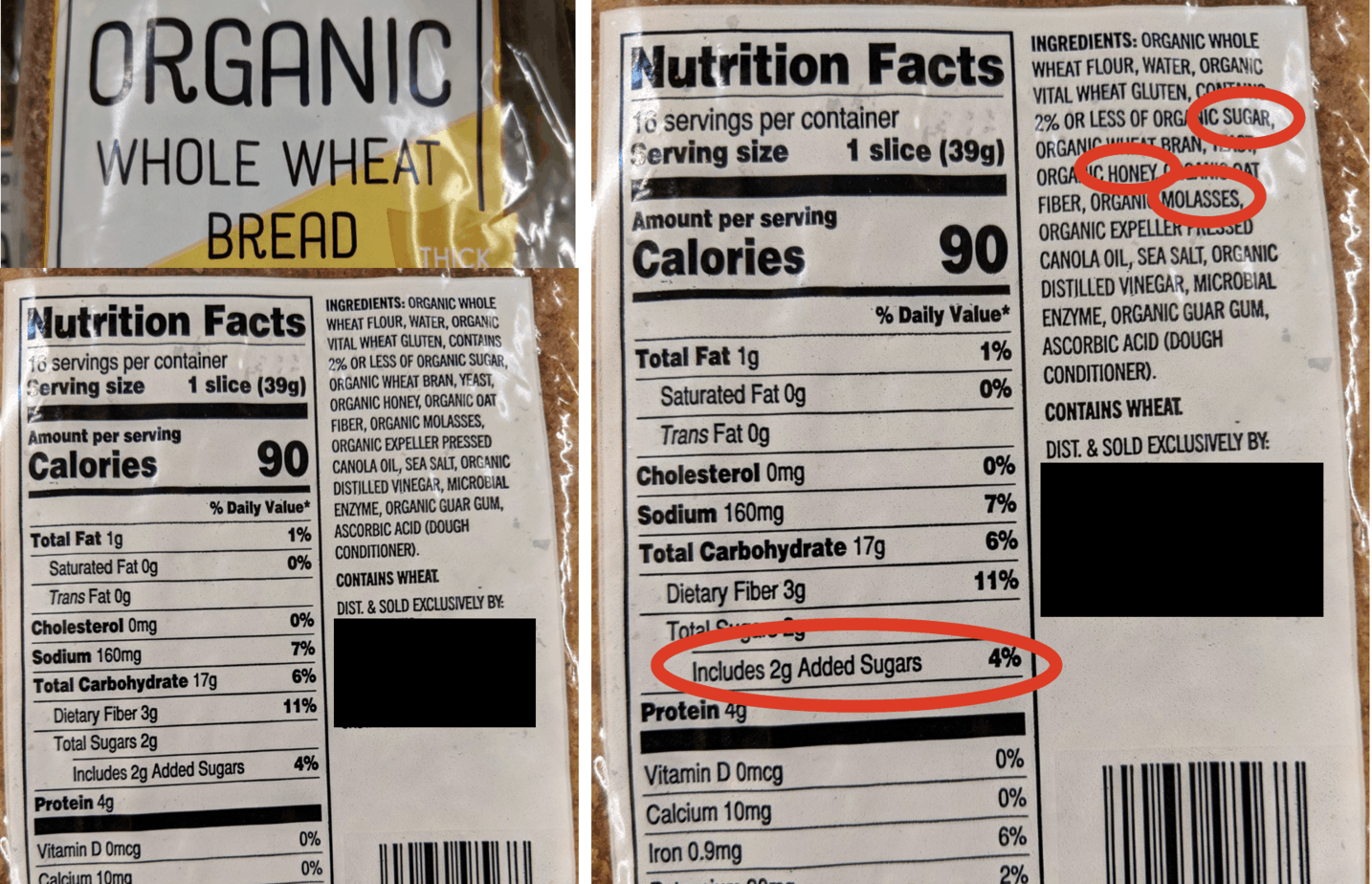Since I started working with adults who want to improve their blood sugar, manage their weight, and reduce their risk for chronic diseases due to inflammation, high blood pressure, or high cholesterol, I have often witnessed their surprise when, together, we start looking into the details of what’s really in the food they eat.
I am not talking about fast food, fried butter, donuts, or other “officially” unhealthy foods. I am talking about foods that many people consume in an effort to establish a healthier lifestyle, because they believe these choices represent nutritious and healthy alternatives. Foods that come with labels such as Non-GMO, Organic, Whole Wheat, Rich in Fiber, Low-Cholesterol, Gluten-Free, etc.
Many people are so sure that these foods are healthy that they pack their children’s lunch-box with them, convinced that they are doing the right thing.
The list of such foods is long, but I would like to highlight just a few here. Are you ready?
1. Whole wheat bread
If you are buying whole wheat bread instead of white bread at the grocery store, you might feel that you are making the right choice by choosing a less processed bread, rich in fiber and much healthier for your body.
Unfortunately, you may want to think twice! Or rather, double-check the list of ingredients!
If you are buying whole wheat bread instead of white bread at the grocery store, double-check the list of ingredients!
Look at the photos below. They show you the nutrition facts both for a whole-wheat bread and a white bread of the same brand. The whole-wheat bread has indeed more fiber, which is nice, but unfortunately, it contains twice as much sugar. Both types of bread have a very long list of ingredients, which is usually an easy way to know that they are highly processed and not very nutritious.
White Bread

Organic Whole Wheat Bread

My suggestion:
If you can make your own bread, go for it! If you think it’s a big hassle, let me tell you that it’s not, once you have the right recipe and the right technique. In less than 20 minutes of work, you can get one or two amazing loaves of rustic French bread. White or whole wheat, it is your choice!
Do you want to learn how to do it? I can show you!
Check out how you can schedule a private class for yourself or for a group of friends and learn how to easily make a no-knead rustic bread from the comfort of your own kitchen!
Now, you might not want to make your own bread and that’s totally fine. There are other alternatives! You could choose Ezekiel bread, which is usually available in the freezer section of your supermarket and doesn’t contain any additives or added sugar.
Even if you only like white bread though, not everything is lost!
Choosing sourdough is often a good option and if you pay attention to the label, you might find some sourdough bread that doesn’t contain any additives or added sugar, even at the supermarket. Of course, it won’t come with as much fiber and healthy nutrients as homemade whole wheat bread, but it’s still a healthy choice in my book, and you can add a nice load of fiber by eating a piece of fruit or an extra cup or two of vegetables.
2. Yogurt
Coming from France where one aisle of a giant supermarket is not even big enough to fit all the yogurt options available, it was a shock to me when I started looking at the nutrition labels of most yogurts in the US.
I have heard many people tell me that in order to eat a healthy breakfast, they have decided to replace their eggs and hash brown with yogurt and granola. Unfortunately, more often than not, their new breakfast menu is not healthier than their previous one, and often less so, actually, when it comes to reducing their sugar cravings or lowering their blood glucose.
Most yogurts are low-fat or no-fat. This, in itself, is not much of an issue. The problem is, when you remove the fat from dairy, you need to add something else to maintain texture and taste. That includes, gum, starch, artificial food coloring, and loads of added sugar! That is especially true for flavored yogurt. The added sugar comes under disguised forms: sometimes it’s plain cane sugar, but it can also be honey, juice concentrate, fructose, dextrose, and more.
The added sugar m yogurt comes under disguised forms: sometimes it’s plain cane sugar, but it can also be honey, juice concentrate, fructose, dextrose, and more.
My suggestion:
You could make your own yogurt, but honestly, I am not sure it’s worth the effort. I used to make yogurts for my family, and did it for about 10 years. Until I realized that there were plenty of healthy options out there, as long as you purchase plain yogurt.
If you are trying to eat enough protein, choosing plain Greek yogurt is an excellent option as it is very rich in protein. Whether you pick the whole-milk version or the low-fat version is totally up to you. If you are trying to manage your weight and reduce your cholesterol, you might want to pick the fat-free on a regular basis and treat yourself to whole milk once in a while. The good thing about Greek yogurt, besides the fact that it is protein-rich, is that even the no-fat version (which is the most common in the aisles) has a satisfying texture on it’s own. It doesn't require additives to make it creamy like other types of yogurts do.
I also like the European-Style yogurt from Trader Joe’s. I buy the whole-milk version as I am not a fan of low-fat dairy in general and would rather eat less of my favorite one rather than a larger portion of the low-fat one.
3. Salad dressing
Eating salad is healthy, right? And even more so when you add tomatoes, cucumber, sprouts, and a bunch of deliciously nutritious vegetables to your bed of lettuce.
Unfortunately, I have seen so many clients deprive themselves from a nice meal at the restaurant and order a salad instead… and then it is served with salad dressing that is loaded with harmful chemicals and added sugar.
Same thing if you are eating salad at home and adding dressing that you have purchased at the store. You probably feel good about the choice you are making, and I commend you for adding salads and vegetables to your daily routine. But alas, chances are, the dressing you add to your salad is largely undermining the health benefits of your mixed greens.
My suggestion:
Make your own dressing!
I won’t even provide store-bought alternatives here, because honestly, making your own salad dressing takes no time at all. You can use a mason jar at the beginning of the week (or month!) and make dressing in less than a minute.
Here is my every-day Salad Dressing Express. It comes with plenty of variations so that you don’t get bored, but when you are in a time crunch, you can really just make it with 2 ingredients in about 12 seconds!
More Tips!
These are just a few examples of supposedly healthy foods that are not healthy at all. But we could write a book on this! Think granola, energy bar, soup, juice... and so many more, unfortunately.
If you want to find out how you can help rid your body of harmful and inflammatory additives while still enjoying delicious meals, reach out to me. Making healthy eating be enjoyable and rewarding is super important to me and this is one of the areas I focus on when working with clients, because I know for a fact that if our food is not exciting, we won't sustain healthy eating habits for very long.
Ready to eat clean and tasty for the rest of your life?
And as always, if you have questions or comments, please feel free to reach out. I am real person and I get a kick out of helping others live a healthier life. Contact me or leave a comment below!

